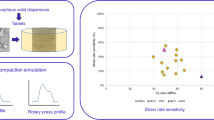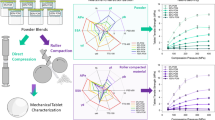ABSTRACT
Air entrapment efficiency of the powders is one of the main factors leading to occurrence of capping or lamination tendency of tablets manufactured from the directly compressible powder blends. The purpose of the current research was to study this underlying cause leading to occurrence of capping or lamination of tablets through evaluation of powder rheological properties. Powder blends were prepared by addition of 0% w/w to 100% w/w of individual active pharmaceutical ingredient (API) [two model API: acetaminophen (APAP) and ibuprofen (IBU)] with microcrystalline cellulose without and with 0.5% w/w Magnesium Stearate as lubricant. Powder rheological properties were analyzed using FT4 Powder Rheometer for dynamic, bulk, and shear properties. Tablet mechanical properties of the respective blends were studied by determining the ability of the material to form tablet of specific strength under applied compaction pressure through tabletability profile. The results showed that powder rheometer distinguished the powder blends based on their ability to relieve entrapped air along with the distinctive flow characteristics. Powder blend prepared with increasing addition of APAP displayed low powder permeability as compared to IBU blends with better powder permeability, compressibility and flow characteristics. Also, lubrication of the APAP blends did not ease their ability to relieve air. Tabletability profiles revealed the potential occurrence of capping or lamination in tablets prepared from the powder blends with high APAP content. This study can help scientist to understand tableting performance at the early-developmental stages and can avoid occurrence capping and lamination of tablets.








Similar content being viewed by others
REFERENCES
Pavliv L, Cahill JF. Drug and biological development: from molecule to product and beyond. Formulation and Manufacturing. New York: Springer; 2007. p. 205.
Carlin BAC. Pharmaceutical dosage forms - tablets. Direct compression and the role of filler-binders. In: Augsburger SWHLL, editor. Informa. 2008. 173–216.
Lachman L, Lieberman HA, Kanig J. The theory and practice of industrial pharmacy. 3rd Indian ed. Compression and Consolidation of Powdered Solids. 1990. p 66–99.
Singh AP, Roye N, Hedman K. Powder rheology using a novel friction tool measuring system. In: Amercian Laboratory News. 2007. p. 1–2.
Maarschalk KV, Zuurman K, Vromans H, Bolhuis GK, Lerk CF. Porosity expansion of tablets as a result of bonding and deformation of particulate solids. Int J Pharm. 1996;140(2):185–93.
Joiris E, Di Martino P, Hermann AM, Guyot JC. Compression behavior of orthorhombic paracetamol. Pharm Res. 1998;15(7):1122–30.
Sun CQ, Grant DJW. Influence of crystal structure on the tableting properties of sulfamerazine polymorphs. Pharm Res. 2001;18(3):284–0.
Sun CC. Setting the bar for powder flow properties in successful high speed tableting. Powder Technol. 2010;201(1):106–8.
Nalluri VR, Kuentz M. Flowability characterisation of drug-excipient blend using a novel powder avalanching method. J Pharm Biopharm. 2010;74(2):388–96.
Mazel V, Busignies V, Diarra H, Tchoreloff P. Lamination of pharmaceutical tablets due to air entrapment: direct visualization and influence of the compact thickness. Int J Pharm. 2015;478(2):702–4.
Tanino T, Aoki Y, Furuya Y, Sato K, Takeda T, Mizuta T. Occurrence of capping due to insufficient air escape during tablet compression and a method to prevent it. Chem Pharm Bull. 1995;43(10):1772–9.
Allen T. Particle size measurement. 3rd ed. London: Chapman and Hall; 1983.
Chaudhari SP, Dave RH. To prepare and characterize microcrystalline cellulose granules using water and isopropyl alcohol as granulating agents and determine its end-point by thermal and rheological tools. Drug Dev Ind Pharm. 2015;41(5):744–52.
Garr JSM, Rubinstein MH. An investigation into the capping of paracetamol at increasing speeds of compression. Int J Pharm. 1991;72:117–22.
Allenspach CT, Zannou EA. Compaction of combination products. In: Celik M editor. Pharmaceutical powder compaction technology. 2 ed. Vol. 197. CRC Press; 2011.
Nystrom C, Glazer M. Studies on direct compression of tablets. XIII. The effect of some dry binders on the tablet strength of compounds with different fragmentation propensity. Int J Pharm. 1985;23:255–63.
Fassihi AR, Parker MS. Formulation effects on capping tendencies. Int J Pharm. 1986;31:271–3.
Akseli I, Ladyzhynsky N, Katz J, He X. Development of predictive tools to assess capping tendency of tablet formulations. Powder Technol. 2013;236:139–48.
Sugimori K, Kawashima Y. A new practical index to predict capping occurring during the tableting process. Eur J Pharm Biopharm. 1997;44:323–6.
Durazo-Cardenas IS, Corbett J, Stephenson DJ. Permeability and dynamic elastic moduli of controlled porosity ultra-precision aerostatic structures. Ceram Int. 2014;40(2):3041–51.
Christensen RM. Defining yield stress and failure stress (Strength). 2011. p. 1–8.
Berry R, Bradley M, McGregor R. Brookfield powder flow tester—results of round robin tests with CRM-116 limestone powder. Proc Inst Mech Eng E J Process Mech Eng. 2014;10(3):40–58.
Jenike AW. Storage and flow of solids. University of Utah; 1964. p. Bulletin 123.
Table breaking force. United States Pharmacopeia and National Formulary (USP 32-NF 27). Vol. Ch. 1217. 2007, Rockville, MD. 726.
Newton JM, Haririan I, Podczeck F. The influence of punch curvature on the mechanical properties of compacted powders. Powder Technol. 2000;107(1–2):79–83.
Fell JT, Newton JM. Determination of tablet strength by the diametral-compression test. J Pharm Sci. 1970;59:688–91.
Li J, Wu Y. Lubricants in pharmaceutical solid dosage forms. Lubricants. 2014;2(1):21–43.
George RE. Avicel® PH microcrystalline cellulose, NF, Ph Eur., JP, BP. FMC Corporation; 2000. p. 1–14.
Faquih AMN, Mehrotra A, Hammond SV, Muzzio FJ. Effect of moisture and magnesium stearate concentration on flow properties of cohesive granular materials. Int J Pharm. 2007;336:338–45.
Hou H, Sun CC. Quantifying effects of particulate properties on powder flow properties using a ring shear tester. J Pharm Sci. 2008;98:4030–9.
Almaya A, Aburub A. Effect of particle size on compaction of materials with different deformation mechanisms with and without lubricants. J Am Assoc Pharm Sci. 2008;9(2):414–8.
Prasad KV, Sheen DB, Sherwood JN. Fracture property studies of paracetamol single crystals using microindentation techniques. Pharm Res. 2001;18(6):867–72.
Van Veen B, Bolhuis GK, Wu YS, Zuurman K, Frijlink HW. Compaction mechanism and tablet strength of unlubricated and lubricated (silicified) microcrystalline cellulose. Eur J Pharm Biopharm. 2005;59(1):133–8.
Armstrong NA, Palfrey LP. The effect of machine speed on the consolidation of four directly compressible tablet diluents. J Pharm Sci. 1989;94(3):465–72.
Tye CK, Sun C, Amidon G. Evaluation of the effects of tableting speed on the relationships between compaction pressure, tablet tensile strength, and tablet solid fraction. J Pharm Sci. 2005;94:465–72.
Wang J, Wen H, Desai D. Lubrication of tablet formulations. Eur J Pharm Biopharm. 2010;75(1):1–15.
Morin G, Briens L. The effect of lubricants on powder flowability for pharmaceutical application. J Am Assoc Pharm Sci. 2013;14(3):1158–68.
ACKNOWLEDGMENTS
The authors are thankful to Division of Pharmaceutical Sciences, Long Island University and Natoli Engineering to provide an opportunity for conducting above research. Also, would like to thank FMC Biopolymer Corp. for donating sample for the present work.
Author information
Authors and Affiliations
Corresponding author
Ethics declarations
Conflict of Interest
The authors report no conflict of interest.
Rights and permissions
About this article
Cite this article
Dudhat, S.M., Kettler, C.N. & Dave, R.H. To Study Capping or Lamination Tendency of Tablets Through Evaluation of Powder Rheological Properties and Tablet Mechanical Properties of Directly Compressible Blends. AAPS PharmSciTech 18, 1177–1189 (2017). https://doi.org/10.1208/s12249-016-0576-1
Received:
Accepted:
Published:
Issue Date:
DOI: https://doi.org/10.1208/s12249-016-0576-1




